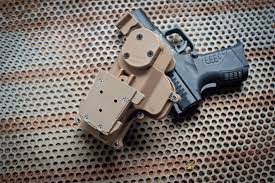In the ever-evolving landscape of concealed carry options, enthusiasts constantly seek comfort, accessibility, and concealment. Among the myriad choices, the Inside-the-Waistband (IWB) holster has become popular among gun owners. But is it the right choice for you? Let’s delve into the world of IWB holsters to understand their advantages, drawbacks, and whether they truly live up to the hype.
Understanding Inside-the-Waistband (IWB) Holsters:
The Inside-the-Waistband IWB holster is designed to be worn inside the pants, providing a discreet and close-to-the-body method of carrying a concealed firearm. This type of holster offers several potential advantages that appeal to a wide range of gun owners.
Pros of IWB Holsters:
- Concealment: One of the primary reasons individuals opt for IWB holsters is their excellent concealment level. The holster sits inside the pants, minimizing the chances of printing (visible outline of the firearm through clothing) and keeping the weapon discreetly hidden.
- Accessibility: IWB holsters allow for quick and easy access to the firearm. Positioned inside the pants, the gun is readily available with a simple lift of the shirt or garment covering it.
- Comfort: Many users find IWB holsters more comfortable than their outside-the-waistband (OWB) counterparts. The holster’s placement inside the pants reduces the chances of discomfort associated with the pressure of the firearm against the body.
- Versatility: IWB holsters come in various designs and materials, catering to different preferences. Whether you prefer leather, Kydex, or a hybrid option, there’s likely an IWB holster that suits your needs.
Cons of IWB Holsters:
- Potential Printing: While IWB holsters are designed to minimize printing, it may still occur depending on factors such as clothing choice, body shape, and the size of the firearm. This can compromise the level of concealment in certain situations.
- Comfort Concerns for Some: Despite the general comfort praised by many users, some individuals may find IWB holsters uncomfortable, mainly if they are not accustomed to carrying them inside the waistband.
- Adjustment Period: Shifting from an OWB to an IWB holster may require an adjustment period. Holster positioning, drawing techniques, and overall comfort may take time to get used to for those new to IWB carry.
Choosing the Right IWB Holster:
When considering an IWB holster, it’s crucial to factor in personal preferences, body type, and the specific firearm you intend to carry. Experimenting with different styles and materials can help determine the most comfortable and practical option for your needs.
Conclusion:
In concealed carry, an IWB holster is an excellent way to carry for many individuals. The blend of concealment, accessibility, and comfort makes it a compelling choice. However, weighing the pros and cons is essential, considering factors such as body type, clothing preferences, and the specific firearm you plan to carry.
In conclusion, choosing an IWB holster ultimately boils down to personal preference and lifestyle. As with any concealed carry method, thorough research and consideration of your needs will guide you towards making an informed and confident choice.
In your quest for the perfect concealed carry solution, remember that what works for one person may not work for another. The key is finding the right balance of comfort, concealment, and accessibility that aligns with your unique preferences and circumstances.


